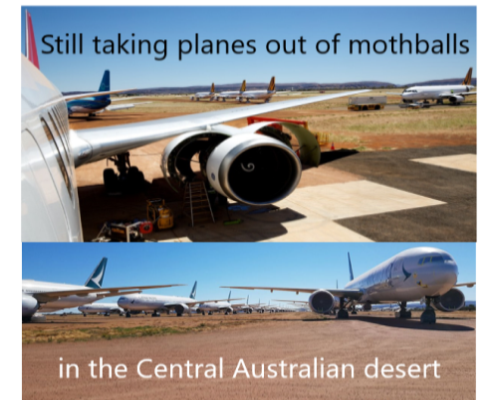Four years ago in April 2020, as the COVID-19 pandemic took hold and global air travel ground to a halt, a number of airlines started flying their aircraft to desert storage in outback Australia, with Asia Pacific Aircraft Storage (APAS) in Alice Springs chosen as their temporary home, for what at the time was an uncertain period.
Later that year (2020), we reported on the uncertainties surrounding international freight, as APAS expanded its facilities to accommodate two hundred more aircraft. Operating from a 100Ha site within the Alice Springs Airport (ASP) complex, which occupies 3,550 hectares, the facility has almost unlimited capabilities for expansion.
Alice Springs offers the perfect environment for the preservation of aircraft and their inherent capital value. It benefits from the arid desert surroundings characterised by an average year-round humidity of approximately 25%, outside Australia’s cyclone zone, low rainfall, and with low lying in-situ vegetation providing additional dust suppression qualities.
Singapore Airlines had placed 27 aircraft in storage at Alice Springs, but on 24 February 2024, some four years after the first ones made their way to the remote outback airport, the final Singapore Airlines aircraft, Boeing 777-300ER 9V-SWJ, was reactivated and flown back to Singapore, for its eventual reintroduction to the fleet.
At the pandemic’s peak over 70 Cathay Pacific and Dragonair-branded planes were parked in Central Australia. At the end of 2022, they had 222 aircraft in their fleet, and around 20% of them were still parked outside of Hong Kong. At this time last year, their aircraft remaining at Alice Springs comprised three A320-200s, two A321-200s, nine A330-300s, eleven B777-300s, and eleven B777-300ERs.
Many have since returned to the sky and Cathay’s intention is to have them all out of hibernation during 2024. An enormous amount of work goes into getting planes ready to fly, with so much attention to detail. Maintenance crew go through every aspect, piece by piece, system by system and wing by wing.
A huge challenge for airlines has been shipping all the necessary spare parts, tools and equipment required into Alice Springs. Those challenges have mostly been logistics-related, with spare parts from Cathay’s Hong Kong HQ, for example, having to be sent via the capital cities – the airport doesn’t have customs or border control. Bulky items have to be transported by road.
Every reactivation is different and presents different challenges. The maintenance team first has to reverse everything they did during the induction process: removing the inhibiting oils, adding fresh oil, removing protective covers and so on. They address any maintenance issues they find and then it’s on to detailed testing of engines, systems and components to ensure the aircraft are fully airworthy for the flight out of Alice Springs.
The airport has two runways and the larger one can operate the largest commercial flights, including Airbus A380s and Boeing 747s (although not fully laden at take-off). ASP is the busiest ‘inland’ airport in Australia after Canberra.
Asia Pacific Aircraft Storage lists among its customers as Qantas, Virgin Australia, Air New Zealand, Singapore Airlines, Cathay Pacific, Tigerair, Cebu Pacific, Garuda Indonesia, Cathay Pacific, Fiji Airways, Scoot and Icelandair.
With the end of the pandemic, APAS is still expanding its vision as one of the world’s main aircraft maintenance and scrap destinations, known affectionately as “boneyards.” Some of the engines they report being certified to maintain include the Airbus A319/A320/A321 series with CFM 56 series and IAE V2500 series engines, as well as the Airbus A330 series with RB211 Trent 700 series engine (others include Airbus A320/A321neo and ATR 72-500/600 / ATR 72-212A).
For more information about airlines and their operations, contact us here at Colless Young. As licensed Customs Brokers and International Freight Forwarders, we offer you correct, professional advice on your air cargo – as well as your seafreight. We are based in Brisbane and handle your logistics needs, both import and export, including quarantine treatments, warehousing and trucking – at all major Australian ports and airports.

